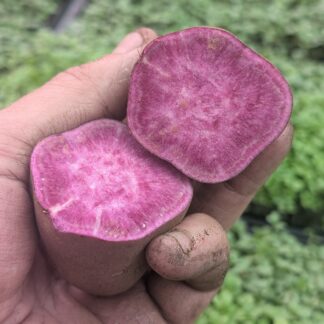Description
Sugarcane (Saccharum officinarum) is a fast-growing, tall perennial grass widely cultivated for its sweet, juicy stems and its many uses in food production, soil restoration, and regenerative gardening. Native to Southeast Asia and the South Pacific, sugarcane thrives in warm, humid climates, favouring full sun and rich, moist, well-drained soils. In Australia, it is commonly grown in tropical and subtropical regions but can also be cultivated in sheltered microclimates further south.
Mature canes can reach heights of 2–4 metres depending on variety and conditions. Sugarcane’s tall, dense growth provides excellent functions beyond sugar production: it creates windbreaks, stabilises soils, suppresses weeds, and adds substantial biomass to the garden ecosystem. Its deep root systems help break up compacted soils and improve structure over time.
The edible stems are harvested for fresh chewing, juicing, or processing into syrup, sugar, and molasses. In some cultures, sugarcane juice is enjoyed as a refreshing beverage rich in natural sugars, minerals, and antioxidants. Although traditionally valued for its energy content, sugarcane also offers organic matter for composting and mulching, making it highly valuable in sustainable agriculture and permaculture systems.
While sugarcane varieties differ slightly in sweetness, colour, and thickness, their general growth habits and ecological contributions remain similar. Some traditional medicinal uses are noted anecdotally, particularly for hydration support and digestive health, but scientific studies are limited.




Reviews
There are no reviews yet.